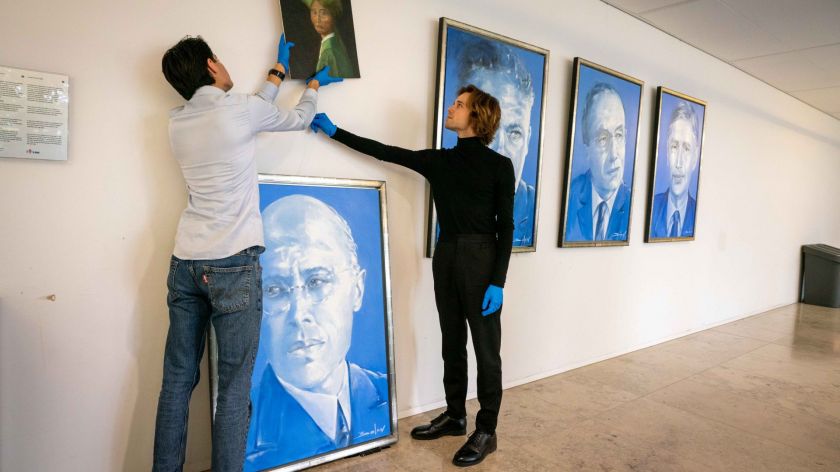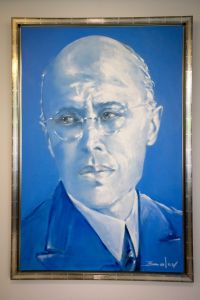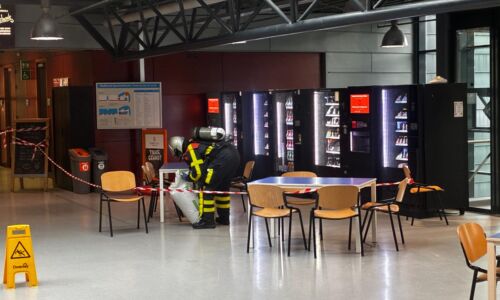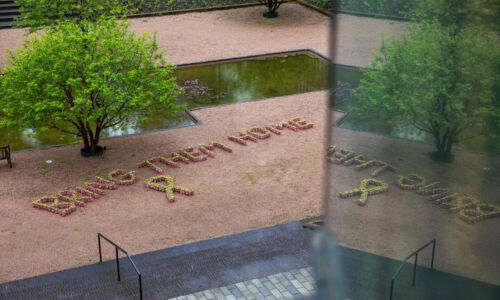Action: Portrait of controversial politician Louis Beel removed from the wall.
-
 Oscar Ekkelboom (left) and Clim Wijnlands taking down Louis Beel’s portrait. Photo: Erik van ‘t Hullenaar
Oscar Ekkelboom (left) and Clim Wijnlands taking down Louis Beel’s portrait. Photo: Erik van ‘t Hullenaar
Students and PhD candidates removed a portrait of Louis Beel from the wall in the Grotius Building this afternoon. Extreme violence was used in Indonesia during his tenure, contributing to the controversial reputation of the former prime minister.
Oscar Ekkelboom very carefully takes Louis Beel’s painting off the wall, before neatly placing it on two rubber mats taped to the ground. In the vacant spot, the PhD candidate and colleague Clim Wijnands hang a painting of Diponegoro, leader of the resistance against the Dutch during the Java War from 1825 to 1830.
‘People have no idea who’s portrayed here’
With this action, the students and PhD candidates want to emphasize that Beel, who served as prime minister from 1946-1948 and 1958-1959, is a controversial politician. Recent research by NIOD, KITLV, and NIMH has shown that under his leadership, the Netherlands used extreme violence to recolonise Indonesia.
Conversation
Ekkelboom, who is also a member of the Committee for the Nijmegen Dutch
East Indies Remembrance, previously wrote an opinion piece on Voxweb. In it, he expressed his surprise that there is a portrait of this man in the Grotius Building without any explanation –Professor Klaas Landsman even called for its removal.

Ekkelboom also discussed this with the Executive Board. Despite this, the painting is still there, and no action has been taken. Additionally, Huize Heyendael has a ‘Beel chamber’; a committee was set to re-evaluate the name.
‘People have no idea who’s actually portrayed here,’ Ekkelboom says as he hands out flyers in the portrait gallery. ‘They might read the nameplates if interested, but there is no mention of what these men have done.’ Beel is portrayed in a row with other prime ministers who graduated from Radboud University: Jo Cals, Victor Marijnen, and Dries van Agt.
On the ground
A group of students and PhD candidates has now included Beel’s portrait in a list of uncomfortable Radboud artworks. The public can vote for the winner during Radboud Art & Science (October 19, 20, 21). The Reframing Radboud project is called ‘Uncomfortable Heritage’ and is a collaboration with the art institution POST.
Other nominees are: the Linnaeus Building (named after Carolus Linnaeus, who classified people into different races); the Catholic tradition of Radboud University (the Catholics are far from uncontroversial); a fetal preparation by curator Fellinger (the fetus did not ask to be displayed); and a pulse train maker (to administer shocks to lab rats). Reframing Radboud’s question is whether the heritage of Radboud University still represents the current identity of the campus.
National hero
Ekkelboom describes the removal of Louis Beel’s portrait as an “artistic intervention.” The painting remains on the ground, until someone from the university – the doorman remained unmoved behind his desk during the action – puts it back in its place.
Until then, Diponegoro’s image, a national hero in Indonesia, adorns the wall. Ekkelboom painted it himself after taking a course in seventeenth-century painting techniques. The PhD candidate worked as a trainee curator at the Rijksmuseum in 2018 and 2019, contributing to the exhibition (Revolusi!) about the Indonesian independence struggle (1945-1950).
Translated by Siri Joustra



